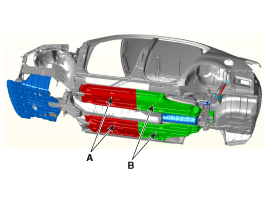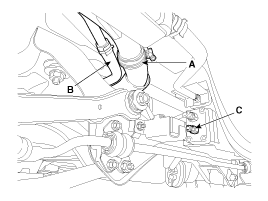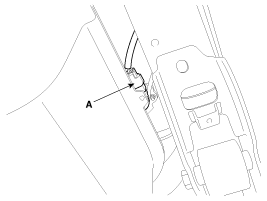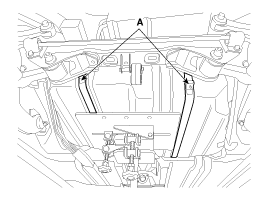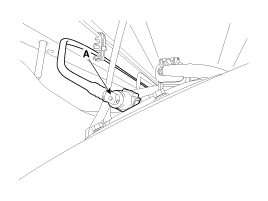Kia Optima Hybrid: Fuel Delivery System / Fuel Tank Repair procedures
| Removal |
| 1. |
Release the residual pressure in fuel line (Refer to “Release Residual Pressure in Fuel Line”). |
| 2. |
Lift the vehicle. |
| 3. |
Remove the front side cover (A) and rear side cover (B).
|
| 4. |
Disconnect the fuel feed tube hose (A), leveling hose (B) and vapor hose quick-connector C).
|
| 5. |
Remove rear muffler (Refer to Engine Mechanical System – “Muffler”). |
| 6. |
Disconnect the fuel pump & fuel tank pressure sensor extension connector (A).
|
| 7. |
After supporting the fuel tank with a jack, remove the fuel tank band (A).
|
| 8. |
Disconnect the fuel feed tube quick-connector (A).
|
| 9. |
Remove the fuel tank.
|
| Installation |
| 1. |
Install in the reverse order of removal.
|
 Repair procedures
Repair procedures
Fuel Pressure Test 1. Release the residual pressure in fuel line (Refer to “Release Residual Pressure in Fuel Line” in this group). When removing the fuel pump relay, a Diagnostic Trouble ...
 Fuel Line Repair procedures
Fuel Line Repair procedures
Removal 1. Remove the fuel tank (Refer to “Fuel Tank”) 2. Disconnect the fuel feed tube (A). 3. Disconnect the vapor hose (A). 4. Disconnect the vapor hose quick-connector (A). 5. Remove the fuel tube ...
Other information:
Kia Optima Hybrid (TF HEV) 2016-2020 Service Manual: Repair procedures
Diagnosis With GDS 1. BSD system defects can be quickly diagnosed with the GDS. GDS operates actuator quickly to monitor, input/output value and self diagnosis. 2. Connect the cable of GDS to the data link connector in driver side crash pad lower panel, turn the power on GDS. 3. Select the vehicle model ...
Kia Optima Hybrid (TF HEV) 2016-2020 Service Manual: Rear Bumper Components and Components Location
Components(1) 1. Rear bumper cover2. Rear under cover assembly Components(2) 1. Rear bumper cover2. Rear reflector3. Rear bumper lower cover4. Rear bumper energy absorber5. Wiring harness6. Rear bumper beam assembly ...

